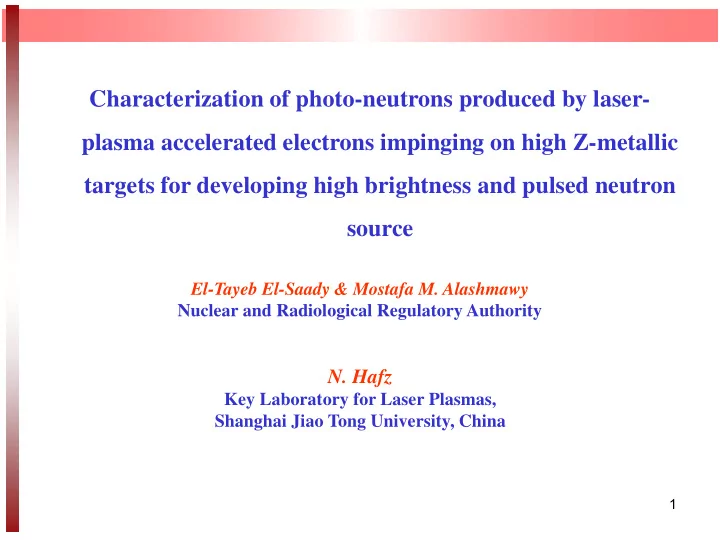

Characterization of photo-neutrons produced by laser- plasma accelerated electrons impinging on high Z-metallic targets for developing high brightness and pulsed neutron source El-Tayeb El-Saady & Mostafa M. Alashmawy Nuclear and Radiological Regulatory Authority N. Hafz Key Laboratory for Laser Plasmas, Shanghai Jiao Tong University, China 1
Ob Objecti ectives ves ♦ Generation of 1.2 GeV and 150 MeV electrons by laser Wakefield acceleration (LWFA). ♦ Electron charge measurements ♦ Plasma density measurements by plasma interferometer. ♦ Generation of pulsed neutrons from 1.2 GeV and 150 MeV electrons by photo-nuclear reaction. ♦ MCNP calculations of Neutron yield, Angular distribution, Energy spectrum and Nuclear Temperature 2
Neutro tron So Sources rces • Fission reaction • Conventional Accelerators • Radioactive sources • Fusion reactions • Laser plasma accelerators
Las aser r wak ake fi field ac acceler elerat ation on (LWFA FA) ultra-intense laser used to excite plasma wave (wake fields) 4
Sh Shan angha hai i Jia iao o Ton ong Las aser r fa facil ilit ity • a tabletop 200 TW, 10Hz, Ti: Sapphire 30 fs laser • 4-mm-long supersonic nozzle gas-jet target N&He • Integrating current transformer (ICT) for electron Charge measurement • Fluorescent screen and a 14-bit CCD camera for imaging the spatial profile of the accelerated electron beams
laser er plasm sma a experim iment ent at KEY laborato atory, y, Shang anghahi ahi Jiao Tong g Uni. EXP.1 1.2 GeV electron is produced from under dense plasma Charge 10pC/p the plasma density (ne) 3.35 × 10 18 cm -3 (Mach-Zehnder interferometer) Pulse duration 30 fs Pulse repetition 10Hz Energy spread 5% EXP. 2 150 MeV electron is produced from dense plasma the plasma density (ne) 4.0 × 10 19 cm -3 Charge 22pC/p Pulse duration 30fs Energy spread 1%
A C 16 Charge Density 8 FWHM 7.1% 0 0.4 0.8 1.2 1.6 Electron Energy (GeV) B Divergence (mrad) ( 10 -4 pC/MeV) 15 15 0 0 -15 0.2 0.53 0.8 1.15 0.3 Electron Energy (GeV) (A) Simulation result using OSIRIS code showing the evolution of the laser pulse electric field (red) and the wake wave’s pseudo -potential difference (black). (B) False-color ICCD image of 1.2 GeV electron beam on the florescent screen after a calibrated magnet spectrometer. This electron beam was generated by focusing 120 TW laser pulse on a 1.8 × 1018 cm-3 plasma of helium gas mixed with low traces of nitrogen gas. (c) The deconvoluted energy spectrum of the image in (B).
MCNP Code de Validation on ♦ Monte Carlo MCNP calculations depend sensitively on the simulation geometry ♦ To check the photonuclear physics contained in the code ♦ Cylindrical lead target (Pb-207) (thickness 1.68 cm and radius 3 cm), for which measured data are available (IAEA TR-188, 1979) ♦ Show good agreement with the published data 1.E+13 1.E+12 Photoneutron Yield (N S -1 kW -1 ) 1.E+11 MCNP IAEA 188 Petwal V. C. et al 1.E+10 1.E+09 8 5 10 15 20 25 30 35 40 45 Incident Electron Energy (MeV)
Neutron Yield 0.4 0.4 0.35 0.35 0.3 0.3 Neutron Yield (neutrons/e - ) Neutron Yield (neutrons/e - ) 0.25 0.25 W 1GeV 0.2 0.2 Ta 150 MeV Pb 0.15 0.15 0.1 0.1 0.05 0.05 0 0 0 20 40 60 80 100 120 140 160 0 20 40 60 80 100 120 140 160 2 ) Thickness (g/cm 2 ) Thickness (g/cm
Max. Yields Target Electron Max. Yield Optimized Optimized (neutrons/e - ) beam thicknes thickness s (g/cm 2 ) energy (cm) 3.47.10 -1 Tungsten 1GeV 140 7.28 Z=74, D=19.24 5.23 .10 -2 150MeV 100 5.2 3.2 .10 -1 Tantalum 1GeV 140 8.5 Z=73, D=16.4 2.98 .10 -1 Lead 1GeV 140 12.35 Z=82, D=11.34
Accelerator Electron electron-neutron electron fluence Max. Neutrons Type beam energy conversion factor (electrons/s) Yield (photons/e - ) (neutrons/s) 3.47.10 -1 0.624. 10 9 2.2 . 10 8 laser plasma 1GeV Acc. 5.23.10 -2 1.37 . 10 9 0.72 . 10 8 150MeV
Angular distribution 0.04 Neutron Fluence ((neutrons-Sr -1 )/ e - ) 0.03 1 GeV 150 MeV 0.02 0.01 0 -90 -70 -50 -30 -10 10 30 50 70 90 Angles (degree) ♦ Giant dipole resonance (GDR), neutrons are produced by photons with energies from threshold energy to 30 MeV ♦ Quasi-deuteron effect (QD) 30 < E < 140 MeV ♦ Photo-pion production above 140 MeV
Energy Spectrum Energy distribution of neutrons produced from 1 GeV electrons incidents on 60g/cm2 thickness of different targets; circles represent simulation data while solid lines represent fittings of such data using Eq − dN E E = n n exp 2 dE T T n
Mean energy of neutrons 8.00E-02 1.00E-01 9.00E-02 7.00E-02 8.00E-02 Neutron Energy Fluence((MeV-cm -2 )/e - ) 6.00E-02 Neutron Fluence((neutron-cm -2 )/e - ) 7.00E-02 5.00E-02 6.00E-02 W W 5.00E-02 Ta 4.00E-02 Ta Pb Pb 4.00E-02 3.00E-02 3.00E-02 2.00E-02 2.00E-02 1.00E-02 1.00E-02 0.00E+00 0 2 4 6 8 10 12 0.00E+00 Thickness (cm) 0 2 4 6 8 10 12 Thickness (cm) target Electron beam energy neutron Mean energy (MeV) Tungsten (W) 1GeV 1.64 Z=74, D=19.24 150MeV 1.58 Tantalum (Ta) 1GeV 1.41 Z=73, D=16.4 Lead (Pb) 1GeV 2.24 Z=82, D=11.34
Calculated Nuclear Temperature T. Target Nuclear Temperature T (MeV) Tungsten (W) 0.44 Tantalum (Ta) 0.57 Lead (Pb) 0.98
Conclusion ♦ GeV class Plasma accelerators can deliver pulsed Neutrons higher than 150 MeV electrons ( 2.2 Χ 10 8 ) neutrons/s. ♦ Tungsten (W) is the best target for neutron production. ♦ Neutrons mean energy ranged from 1.4 - 2.24 MeV ♦ Over 23% in forward direction from the peaked forward angular distribution ♦ The Ultra Short Pulsed Neutrons (tens femto second) can be used in lab scale TOF for elemental and isotopic identification with minimum signal to noise Ratio ♦ The peak forward angular distribution can support linear design of TOF unit 16
Thanks
Recommend
More recommend